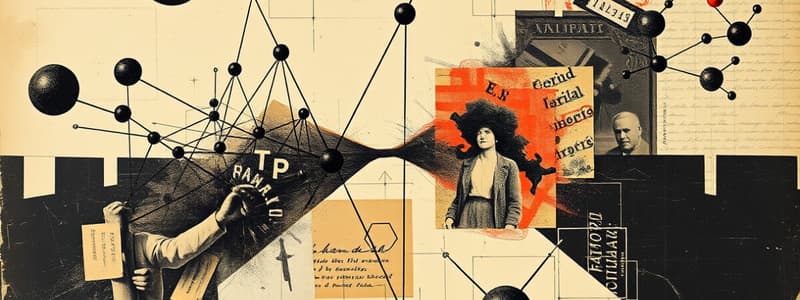Podcast
Questions and Answers
What is an ion?
What is an ion?
- A type of atom that has a different number of neutrons.
- A molecule that has a high boiling point.
- A species of an element in which the number of electrons does not equal the number of protons. (correct)
- A species of an element with equal number of electrons and protons.
What defines an isotope?
What defines an isotope?
- Atoms with the same number of protons.
- Atoms that are electrically neutral.
- Atoms with a different number of neutrons. (correct)
- Atoms that are polar.
What does isoelectric mean?
What does isoelectric mean?
- Atoms that are chemically inert.
- Two elements that can form stable bonds.
- Two atoms with the same charge. (correct)
- Two atoms with the same number of neutrons.
What is isomer?
What is isomer?
What is the formula for Gibbs Free Energy?
What is the formula for Gibbs Free Energy?
Molar volume of an ideal gas at STP is 22.414 L/mol.
Molar volume of an ideal gas at STP is 22.414 L/mol.
What does molarity measure?
What does molarity measure?
What is a bomb calorimeter used for?
What is a bomb calorimeter used for?
The lighter a gas's atomic weight, the faster it will escape a container according to _____ Law of Effusion.
The lighter a gas's atomic weight, the faster it will escape a container according to _____ Law of Effusion.
Flashcards are hidden until you start studying
Study Notes
Ionic and Atomic Concepts
- Ion: Species formed when the number of electrons differs from protons, resulting in a net charge.
- Isotope: Variants of an element that contain different numbers of neutrons, affecting atomic mass.
- Isoelectric: Atoms or ions that possess the same charge, despite differing in elemental identity.
- Isotopic: Refers to atoms sharing the same number of neutrons.
Molecular Geometry and Bonding
- Tetrahedral Bond Angle: 109.5°, characteristic of tetrahedral molecular geometry.
- Trigonal Planar: Arrangement of three atoms around one central atom, typically non-polar.
- Linear and Bent Shapes: Linear involves two surrounding atoms (non-polar), while bent has one non-bonding pair and two atoms (polar).
- Tetrahedral and Trigonal Pyramidal: Tetrahedral involves four surrounding atoms (non-polar), while trigonal pyramidal has three atoms and one non-bonding pair (polar).
Hybridization and Bond Types
- Hybridization: Mixing of standard atomic orbitals to create new orbitals for bonding.
- Sigma Bonding: Formed via head-on overlapping of orbitals.
- Pi Bonding: Involves side-by-side overlapping of orbitals.
- Coordinate Covalent Bonding: A type of covalent bond where both electrons originate from the same atom.
Radicals and Octets
- Free Radicals: Molecules with an unpaired electron, typically reactive (e.g., NO₂).
- Incomplete Octets: Stable configurations with fewer than eight electrons (e.g., BF₃).
- Expanded Octets: Stable configurations exceeding eight electrons, common from the third row of the periodic table (e.g., XeF₂).
Structural Concepts in Chemistry
- Resonance Structures: Different valid electron arrangements for a molecule that represent a hybrid state.
- Polar Molecule: Molecules with an uneven distribution of charge, typically having regions of partial positive and negative charge.
- Formal Charge Calculation: V - N - (B/2) where V is valence electrons, N is non-bonding electrons, and B is bonding electrons.
Thermodynamics and Energy
- Gibbs Free Energy: Relates to spontaneity, calculated by ΔG = ΔH - TΔS.
- Enthalpy and Entropy: Enthalpy (ΔH) signifies energy changes, while entropy (ΔS) indicates the degree of disorder.
- Bond Energy: Energy required to break bonds, equal to energy released when forming bonds.
Chemical Properties and Reactions
- Combustion Reaction: General equation for hydrocarbon combustion: CₓHᵧ + (x + y/4)O₂ → xCO₂ + y/2H₂O.
- Limiting Reagent: The reactant that is entirely consumed first in a chemical reaction.
- Molar Volume: Volume occupied by one mole of substance, specifically 22.414 L/mol for ideal gases at STP.
Heat and Specific Heat
- Specific Heat: Amount of energy required to alter the temperature of one gram of a substance by one °C.
- Molar Heat Capacity: Similar to specific heat, but focuses on raising one mole of a substance by one °C.
- Bomb Calorimeter: Insulated device used to measure heat of reactions at constant volume.
Additional Concepts
- Normal Melting Point: Temperature where a solid's and liquid's phases are in equilibrium at atmospheric pressure (760 mm Hg).
- Graham's Law of Effusion: States lighter gases effuse faster than heavier gases due to differences in molecular weight.
Studying That Suits You
Use AI to generate personalized quizzes and flashcards to suit your learning preferences.




